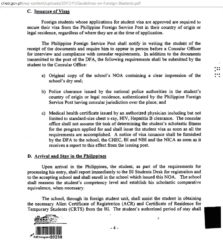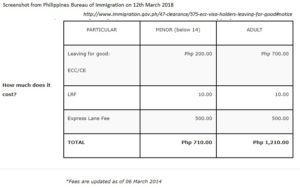Is it cheaper to overstay a visa rather than pay for the visa extension?
I was asked this question recently, as it appears that many people seem to think that the overstay fines are cheaper than paying for a Visa renewal.
Having heard this a few times, I am beginning to think that this might be the reason why so many foreign visitors to the Philippines end up not renewing a visa, and overstaying for so long.
At least some of them think the fine is cheaper than a visa, and don’t bother renewing their entry visa, expecting to just pay the fine when they leave.
Unfortunately for them, they eventually find out that while the fine is cheaper than a Visa, it is not as simple as that.
- A Two Month Visitor visa will cost about 6,650 pesos. Consisting of 3,650 php + about another 3,000 (depending on USD-PHP FX rate) pesos for the ACR-I card (according to www.immigration.gov.ph).
- The Fine for overstaying for just under two months is 1,500 pesos. (Consisting of 1,000 pesos [Fine for Overstaying 2 months] + 500 pesos [Motion for Reconsideration for Overstaying]).
For some people, they see those two figures and think that it is best to pay the 1,500 pesos.
But the reality is VERY DIFFERENT to that:
What you actually pay is:
- The Fine PLUS outstanding unpaid visa fees; ie: 1,500 plus 6,650 in the above example, a total of 8,150 pesos.
- PLUS, depending on how long you overstayed, you may be banned from re-entry.
It is often best to know the full facts.
Some people, who have overstayed, and expect to pay the fine at the airport, and then leave, actually end up paying an even higher price…
- You don’t pay the fine at the airport, you are normally refused boarding, and told to go to an immigration office, normally in the nearest city, and sort out your visa issues there, and come back later, often the next day, or later.
This comes with TWO costs.
- Inconvenience to you, and the cost of an extra night or two at a hotel, while they sort out the visa issues, and arrange an exit certificate if applicable.
- The cost of new flights, unless your ticket was fully convertible to a new flight. Most are not.
I was told that the hotel costs are not always involved, as a stay at the Bureau of Immigration Bicutan Detention Centre can be an option, for Immigration to decide. I personally do not know anyone who was jailed, but I have heard people talking about other people who were. I have also read about some who were, although not 100% sure on the full story of each case.
and more….
Philippine Star News Article on November 27, 2016
www.philstar.com/…/bi-eyes-building-more-jail-cells-overstaying-foreigners
MANILA, Philippines – Bureau of Immigration (BI) Commissioner Jaime Morente wants to construct another building for its jail at Camp Bagong Diwa (Bicutan Detention Centre) prior to cracking down on around 500,000 foreigners illegally staying in the country.
“We want to conduct nationwide operations but the problem is we do not have (enough cells) to house those who would be arrested for overstaying,” he said in a recent interview.
Morente said the bureau’s jail, a “squatter” in the National Capital Region Police Office compound at the camp, has two two-story buildings. Morente wants to construct a third two-story building.
My view is that detention for a small overstay is very unlikely, although it is legally possible, if they don’t like you for some reason.
Another story:
The Bureau of Immigration (BI) on Thursday (March 30, 2019) reported the arrest of an overstaying Vietnamese couple for attempting to leave the country with fake immigration stamps on their passports. The couple had been in the country since June 5, 2018 (10 months).
“Instead of applying for the extension of their stay and pay the required fees, they chose to deal with fixers who make a living by selling these fake stamps to overstaying foreign tourists,” he said.
The BI official noted that the fraudulent scheme was discovered after their personnel noticed that the passports did not have departure stamps from the foreign nationals supposed previous arrival.
They are currently detained at the BI detention facility in Camp Bagong Diwa, Taguig City pending their prosecution for violating the Philippine Immigration Act. (pna.gov.ph)
Story Link:
How much are the Penalties for Overstaying as a Tourist in the Philippines?


